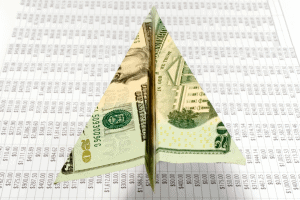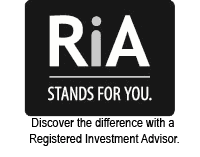Download the PDF copy here
Executive Summary
- Last quarter we discussed the importance of bringing down inflation and how the strength of the consumer and corporations was at crosscurrents to the Federal Reserve’s efforts to contain inflation. When the Fed raises the federal funds rate, it is aiming to boost short-term borrowing costs throughout the economy. This in turn reduces the supply of credit and makes loans more expensive for everyone. This can quell rising inflation by reducing the amount of money flowing through the economy. Thereby reducing demand for goods and services.
- Further, we expressed hope that the free capitalistic system would bring supply in line with demand and bring inflation to a heel before the Federal Reserve’s action reduced demand to the point of recession.
- This quarter, we will review the progress of lowering inflation as well as the financial well-being of consumers and corporations.
- Inflation is a trailing economic indicator. Impacting the path of inflation with Federal Reserve Bank monetary action is difficult in that the Fed must act and then wait to measure the resultant inflation. It is like driving a car by looking out the rearview mirror.
- Complicating the Fed’s task is that they can only control short-term interest rates by adjusting the overnight federal funds rate, but the securities market participants (Mr. Market) as a whole control bond prices via their announcement of plans of action and forecasts for economic measures.
- Mr. Market doesn’t always agree with the Fed’s projections. Sometimes Mr. Market thinks the impact of the Fed’s actions will take longer or shorter than the Fed estimates.
- More recently, Mr. Market thinks there is a longer lag between the Fed’s actions and their impact. Therefore, Mr. Market believes the Fed’s actions have been strong enough to induce a recession later this year, forcing the Fed to lower interest rates before year end. At present, the Fed believes the lag between their actions and the resultant impact on the economy is shorter. They believe the economy is resilient and pessimism is overdone. As a result, they plan to apply more restrictive policies for longer. So far, the data regarding employment and inflation support the Fed’s view.
- The truth is, Mr. Market is also driving by looking out the rearview mirror. But, when Mr. Market disagrees with the Fed, Mr. Market’s bidding (lower intermediate term bond yields) makes the Feds job of lowering inflation via restrictive interest rates more difficult.
- Therefore, we will continue to wait and watch the macroeconomic data for clues of success (or lack thereof) in the battle to bring down inflation. All headlights will be on readings for inflation and interest rates.
- The Fed is attempting to refine their measure of inflation in areas that most concern them. We will look at these measures.
- A sneak peek: the economy is showing resiliency while inflation measures are trending down.
- There is a lot of great information on pages 2 through 5, but if you are a bottom-line person seeking to save time, reread the last bullet, and read the Wrap-up on page 6.
Macro-Economic Perspective
- After declining in Q1 and Q2, real Gross Domestic Product (nominal GDP less inflation) growth experienced a very good recovery at 2.9% in Q3 and 3.2% in Q4. Year over year, real GDP growth for 2022 was 1%.
- Real GDP projections: Projections for real GDP growth in the USA center on 0.5% for 2023. As recently as a few weeks ago most economists and big banks put the chances of a recession this year at greater than 60%. More specifically, they anticipate a recession by mid-year and a recovery before year end. Some foresee rolling recessions, first in goods, then in services. All of this points to a mild recession instead of an across-the-board economic slump. But, then the Bureau of Labor Statistics reported a gain of 517,000 jobs in January. And after falling in the last two months of 2022, retail sales spiked in January by 3%. This is the largest jump in two years. Regarding the decline in retail sales in November and December – although the numbers declined month over month, they were up 6.2% and 6.7% respectively year over year.
- Money Supply (M2 – cash, checking and savings deposits, money market, mutual funds, and CDs). Not only has the Fed raised the federal funds rate by 4.5% over the last year, but they have also worked to curtail money supply by allowing bonds on their balance sheet to mature without replacement as well as selling bonds from their balance sheet. Typically, the Fed maintains M2 money supply growth of 3% to 6% in their quest for economic growth and maintenance of stable prices with a target of 2% inflation. Monetary tightening alert: Money Supply (M2) growth was zero or negative 8 out of the last 9 months of 2022, finishing the year down 1.3% from the end of 2021.
- The velocity of money (the frequency at which one unit of currency is used to purchase goods and services within a given period) rose 7.3% last year from 1.14 to 1.225, which is still exceptionally low. A more typical reading is 1.6 to 1.9. As a result, this has not compounded the inflation problem. We anticipate that this reading will remain low.
- Inflation: Data suggests inflation has peaked, but its progression down is not a straight line.
- The Federal Reserve’s goal is to achieve a return to an inflation rate of 2%.
- Headline readings for the Consumer Price Index (CPI) peaked in June last year at 9.1% and have declined steadily to 6.4% in January this year. Core CPI (excludes food and energy) peaked in September at 6.6% and was 5.6% in January.
- The Federal Reserve’s preferred measure of inflation is the Personal Consumption Expenditures (PCE) Index. The PCE appears to have peaked in June at 7% and has declined steadily to 5% in December. Year-over-year readings for the Core PCE Index have declined each month from 5.2% in September to 4.4% in December. The annualized rate in Q4 was 2.9%. This is encouraging.
- Goods inflation has come down with solutions to supply chain logistics issues. Core goods inflation (22% of inflation) was 12.3% in February 2022, but rose only 2.2% year over year in December. For the three months ending in December, core goods prices actually fell 4.8% on an annualized basis. The readings in November and December were -1.9% and -3.0%, respectively.
- Service inflation is a bigger concern of the Fed given the strength of employment. More specifically, the Fed recognizes wages as the main determinant of service prices. The 12-month change in wages dropped from 5.6% in March to 4.6% in December. Wages grew at a 4.1% annual rate in the three months ending in December. Not only is the trend down, but the annualized rate in Q4 is not much above the 3% to 4% that is compatible with the Fed’s inflation target assuming productivity gains.
- Core services inflation (excludes energy) is also impacted by Shelter (housing) prices. The 12-month inflation rate for shelter ending in January 2023 was 7.9%. Expectations for shelter inflation are to reach a 3% annualized rate by the end of 2023. (Further discussion is in the housing section at the top of page 5).
- Supercore inflation is a measure of core service inflation with housing cost stripped out. The Fed does not include housing prices in this category because of the delay for new rents and mortgages to be seen in the data. Supercore inflation was coincidentally the same as overall wage inflation at 4.1% for the three months ending in December. This is still above the Fed’s target (estimated to be 3.3%) and given as the Fed’s reason to continue with higher interest rates.
- Inflation Expectations are coming down:
- The Fed’s median projection for Core PCE inflation for 2023 through 2025 is 3.5%, 2.5%, and 2.1%, respectively.
- Consumer expectations for inflation have a significant impact on its future course. In January, the New York Federal Reserve bank survey of consumer expectations for inflation in one year, three years, and five years were 5%, 2.7%, and 2.5%, respectively.
- The bond market determined 5-Year and 10-Year Break-even Inflation rate was 2.27% and 2.26%, respectively, at 2022 year end.
- Another measure of one year inflation expectations is the difference between the Treasury Bill and the Treasury Inflation protected security with one year maturity. It is presently 3%.
- Consumer financial well-being is still good but declining.
- The personal savings rate has declined from 8.8% in 2019 prior to the pandemic, after rising to double digit levels in 2020 and 2021, to below 3% for the last three months of 2022. In the aggregate, inflation has deteriorated consumers ability to save.
- Based upon an estimate of excess household savings at $1 Trillion from $1.7 Trillion at the end of 2021, median household cash reserves remain approximately 30% higher than prior to the pandemic. Economists are estimating that the benefits of the excess savings pool have largely been or soon will have played out. Remaining excess savings will not likely flow towards consumption.
- Despite nominal annualized pay raises of more than 5% for the first three quarters in 2022 and 4.1% in Q4, real disposable income was down 2.1% in Q1, down 1% in Q2, down 0.3% in Q3, and up 0.5% in Q4. The trend is right, but this explains the decline in the savings rate and reduction in excess savings.
- Real personal consumption expenditures, a comprehensive measure of consumer spending shows rising expenditures after adjusting for inflation – up in Q1, Q2, Q3, and Q4 at 1.24%, 0.7%, 0.6%, and 0.5%, respectively.
- Household net worth reached $111.04T at the year-end 2019. Since then, it had risen 28% to $150T at the end of 2021. At Q3 end, it declined to $135.3T. The 2021 year-end value looks like a near term peak, but household net worth continues to be supportive of economic growth. Source: Federal Reserve (December 2022 reading comes out in March).
- Between the 4th quarter of 2019 and the 3rd quarter of 2022, the bottom quintile of consumers’ net worth improved by 42%. The top quintile of consumers’ net worth increased 22.2%.
- This all-encompassing measure of consumer financial well-being provides a picture of good health.
- Anecdotal evidence of consumer stress with inflation appears in emergency withdrawal rates from 401(k) accounts. The pre-pandemic rate was 2%. It rose to 2.1% in 2021 and 2.8% in 2022 at two of the largest 401(k) providers, namely, Vanguard and Fidelity.
- Employment: Big progress in service industry hiring.
- Technology company layoffs are grabbing the headlines, but the industry represents just 2% of private sector jobs.
- Service industry employees in healthcare, education, leisure, hospitality, and other services represent 36% of all private sector jobs. These service industries added 1.19 million jobs over the past six months. This accounts for 63% of all privatesector job gains during that time, up from 47% in the preceding year and a half.
- Business owners are finding it easier to fill jobs. This is being attributed to bigger paychecks and benefits, diminishing fear of getting sick, and financial worries amid high inflation.
- Labor-force participation for women in their prime working years of 25 to 54 returned to pre-pandemic levels in January 2023.
- The Labor Department reports that, as of December, the leisure and hospitality sector had about a million more unfilled jobs than before the pandemic.
- Macro-economic Summary or Conclusions
- Real income down, real expenditures up, equals reduced personal savings.
- The economic aid of excess personal savings (above pre-pandemic level) is nearly used up.
- Labor supply is still tight. But corporations are reporting greater ease in hiring. Consumers feeling the pressure of high prices and higher interest rates as well as declining fear of getting sick may be leading to more people returning to work, i.e., an increase in employment participation rate is underway. Let’s hope so.
- Wage growth is strong, but slowing, with hourly wages in lower-paying service jobs advancing more rapidly than the private-sector average. Layoffs, outside of a few sectors, remain historically low.
- Huge progress has been made in goods inflation where most supply constraints have been resolved.
- Corporate capital investment ran hot at 20% for most of 2022. This has been instrumental in lowering core goods inflation to 2.2% year over year in December. Disinflation occurred in Q4. Corporate capital investment growth has dropped to a more normal 6% recently. This seems like a vote of confidence in the economy.
- The Federal Reserve bank has been aggressive with money supply shrinking in 2022 and the Federal Funds rate up 4.5% in one year. More tightening and continued tight conditions will remain in place until a path to 2% inflation is visible.
- The U.S. economy rallied in the 2nd half of 2022, yet inflation is trending down. Also, inflation expectations are trending down. This provides some optimism for a soft landing (short and shallow recession) or no landing at all (no recession).
- Is there a case that the free capitalistic system and Fed tightening can combine to bring down inflation without killing the patient? A few weeks ago, the question would have been laughable. Now, we are not so sure.
Key Segments of the Economy
Consumer spending (70% of GDP): In 2022, real personal consumption expenditures rose 2.2% over the year ago level. The Institute of Supply Management (ISM) reading for service ran in the mid-50’s most of the year. It dropped to 49.2 in December but rebounded to 55.2 in January 2023. 50 is the dividing line between decline and growth.
Manufacturing (11% of GDP): The ISM reading for manufacturing trended down for the year from 57.6 in January to 48.4 in December. The reading dropped below 50 in November. It remained below 50 at 47.4 in January 2023. The Federal Reserve reported year-over-year gains in industrial production each month this year. Ranging from 2.8% in January, to a high of 6.7% in February, 4% in June, 5.3% in September, but only 1.1% in December. Industrial production recorded month-over-month declines in November and December. This corresponds to resolution to goods supply constraints and oversupply in consumer goods including electronics.
Construction (4.1% of GDP): This data is not adjusted for inflation, but total $ spent on construction was up 7.7% in 2022. Residential construction was up 1.6%. But the carnage of higher interest rates is evident. Residential construction spending was down month-over-month for the last six months of the year. Single family starts were down 25% last year. Multi-family starts were very high in late 2021 and early 2022 but were down 20% in 2022. Combined residential starts were down 22%. Residential permits were down 29.5%. Non-residential construction was up 13.8% in 2022. There isn’t any evidence of a slow-down in non-residential construction. (Data from U.S. Census Bureau and Federal Reserve of St. Louis)
Home sales: The impact of high prices and higher interest rates are being felt in existing and new single-family home sales. The National Association of Realtors (NAR) reported that combined existing and new home sales declined 33% in 2022 from 6,929,000 to 4,636,000 units.
The supply of homes for sale has risen from 1.7 months at the end of 2021 to 3.2 months at the end of This is still low, but a good trend for affordability. Six months’ supply is considered a balanced marketplace for buyers and sellers. Estimates of the shortage of housing units in the U.S., occurring after the housing/financial crisis is about 3,000,000.
Housing affordability is a significant issue. Additional housing supply is needed, but higher interest rates will conflagrate the problem before it can get better. The National Association of Realtors provides a Housing Affordability Index. In the calculation of the index, they calculate the Payment as % of Income. This figure has risen from 14.7% in 2020 to 24.1% in 2022. This measure of affordability along with the large overbuild of apartments in 2021 and early 2022 is evidence that home prices and apartment rents will continue to ease sharply. This will help bring down inflation, but it will take years to resolve the affordability problem.
Securities Market Perspective
For the year 2023, a 100% stock portfolio with 20% invested in international was down 17.31% with dividends reinvested. This represents a nominal improvement of 7% from the end of the third quarter. Intermediate term bonds (Bloomberg Aggregate Bond Index) were down 13.01%, and short-term bonds were down 3.69% (Bloomberg U.S. Gov’t Credit 1 to 3 Year Bond Index).
Prior to 2022, DBFM had moved a heavy portion of bonds into short term from intermediate term in anticipation of rising interest rates. We continued this process as rates increased last year. Longer term bond prices are more negatively impacted by interest rate increases. The risk of pulling out of intermediate term high quality bonds (Bloomberg Intermediate Term Bond Index) is that these bonds would likely perform better should recession conditions become obvious as investors would move money into them for safe keeping and anticipation of a peak in interest rates. This action would drive the bond prices up / yields down. To account for the possibility of recession, the intermediate term bonds shifted to short term were invested in high quality. Although, we did keep allocations to satellite bonds (lower credit quality, alternatives, floating rate, and preferred stocks) unchanged. Bond yields now appear attractive, however with the FED intent on combating inflation via higher interest rates, we are not yet comfortable increasing duration of bond portfolios. Meanwhile, the peak of the Treasury bond yield curve is at the short end. In retrospect, the heavy allocation to short term bonds significantly lowered the downside in the fixed income portion of portfolios.
Stocks have also reacted negatively to the prospect of continued high inflation and higher interest rates. Especially for growth stocks. At the end of 2022, the weighted average return for domestic growth stocks was -28.8%, and the weighted average return for domestic value stocks was -7.43%. Value stocks were leading all stocks by 10.68% through the end of the year.
At the end of 2022, as measured by price to book value, growth stocks were 77% above their long-term average of 4.83 at 8.57, a significant improvement from a peak level of 180% (2021 year-end) above the long-term average, but still quite high. Value stocks were 15% above their long term average of 2.03 at 2.33, an improvement from a peak level of 23% (2021 year-end), but an increase from 2% at the end of the third quarter.
After increasing use of quality growth mutual funds in 2020 to take advantage of the stay-at-home tech success, we eliminated mid-cap and small cap quality growth in 2021 and continued to reduce exposure to large cap quality growth funds throughout 2022. True to form we continue to favor value stocks. This enabled strong relative performance on the equity portion of portfolios in 2022.
While 82% of companies have reported 4th quarter results, 68% of the S&P 500 had profit results above analyst’s estimates, compared with the five-year average of 77%. Q2 earnings growth for the S&P 500 was 8%. Q3 earnings growth for the S&P 500 was 2.2%. Q4 earnings declined 4.7% (less than 100% of companies reporting) according to FactSet Research. Economic recession or not, corporate earnings have completed the first leg of an earnings recession. Hopefully, we are near the bottom of the corporate earnings cycle. In 2023, through February 17th, the S&P 500 with dividends reinvested is up 6.5%. The returns are generous in the face of the 4th quarter earnings decline. Mr. Market either thinks we are near the bottom of the corporate earnings cycle, or he is looking beyond it, shallow recession implied. Perhaps Mr. Market is a bit ahead of himself. We shall see.
Wrap-Up
Quoting from an editorial in the Wall Street Journal on 2/9/22 by Alan Blinder, professor of economics and public affairs at Princeton and former Vice-Chairman of the Federal Reserve: “Consider these amazing facts. When the Fed started tightening in March 2022, the unemployment ate was 3.6%. Since then, about four million net new jobs have been created, and the unemployment rate today stands at 3.4%. Yet inflation has come way down, not up; wage increases are moderating, not increasing; and less inflation from rents is in our future. We also know the effect of tight money on inflation is long delayed. Maybe, just maybe, the Fed can finish off the dragon without killing the economy”.
We would only add that a pat on the back is deserved for corporate efforts to negotiate and affect a tough situation. The battle has not yet been won, but it is being well managed.
In the meantime, we remain long term bullish, seeking necessary or opportunistic tactical adjustments to portfolios, and remain diversified for long term success.
Please feel free to contact us with any questions, or if you would like to schedule a face to face, virtual, or phone meeting.
Thank you,
Dave Dickmeyer, M.B.A.
Wealth Advisor
Principal Owner
Ian D. Boyce, CFP®
Certified Financial Planner™
Principal Owner
Drew Lanphear, CFP®, RICP®
Certified Financial Planner™









